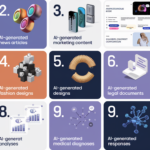As we prepare to advance in AI, As we are getting ready to advance in AI, Transformers have emerged as a groundbreaking architecture, fundamentally changing how machines process and understand information. This article delves into the key areas where Transformers are making significant impacts and explores ongoing discussions within the AI community. fundamentally changing how machines process and understand information. This article delves into the key areas where Transformers are making significant impacts and explores ongoing discussions within the AI community.
1. Transformers in NLP and Beyond
Transformers initially gained prominence in natural language processing (NLP) due to their ability to capture context more effectively than previous models like RNNs or LSTMs. Their architecture allows them to understand relationships between words in a sentence, regardless of how far apart those words are[1]. This is especially important for tasks such as machine translation, sentiment analysis, and text summarization.
Expanding Beyond Language
The influence of Transformers has extended far beyond NLP. Vision Transformers (ViT) have shown that the same attention mechanisms can be applied to image processing, challenging the dominance of convolutional neural networks (CNNs) in computer vision[1]. This versatility has opened up new possibilities in various fields:
– Speech recognition
– Protein folding prediction
– Music Generation
– Video understanding
The ability of Transformers to handle different types of sequential data has made them a versatile tool across multiple domains in AI research and applications.
2. Scaling and Performance
One of the key reasons Transformers have become so powerful is their ability to scale. Models like GPT-3 have hundreds of billions of parameters, allowing them to generate text that’s almost indistinguishable from human writing[2]. This scaling has led to breakthroughs in generating coherent and contextually relevant text, enabling applications ranging from chatbots to automated content creation.
Challenges of Scale
However, the trade-off is that these models are resource-intensive. Training a model like GPT-3 requires massive amounts of data and computational power, raising concerns about:
– Accessibility: Only well-funded organizations can afford to train and run such large models
– Environmental impact: The energy consumption of training and running these models is significant
– Efficiency: Researchers are exploring ways to make Transformers more efficient, such as through model compression techniques and reducing the number of parameters without sacrificing performance[2]
3. Ethics and Social Impact
The power of Transformer models brings significant ethical challenges:
– Misinformation: These models can generate text that mimics human writing, risking the production of misleading or harmful content
– Bias: If the data used to train a Transformer contains biases, the model can perpetuate and even amplify those biases in its outputs
– Job displacement: There’s growing concern about the societal impact of deploying such powerful AI models, potentially leading to automation of tasks in industries such as journalism, customer service, and creative arts[3]
Balancing the benefits of these technologies with the need for ethical oversight and societal considerations is an ongoing debate in the AI community. Researchers and policymakers are working on developing guidelines and regulations to ensure responsible development and deployment of AI technologies.
4. Future Research Directions
Looking ahead, several exciting avenues for research in Transformer models are emerging:
Efficient Transformers
Developing methods to reduce the computational and memory footprint of Transformers is a priority. Promising approaches include:
– Sparse attention mechanisms
– Model pruning
– Knowledge distillation techniques
Multimodal Transformers
Combining different types of data (e.g., text, images, audio) in a single model could lead to AI systems that understand context more holistically, improving applications like:
– Autonomous driving
– Interactive AI assistants
– Cross-modal content generation
Explainability
As Transformers are used in more critical applications, such as healthcare or finance, making their decisions transparent is crucial. Research into explainable AI (XAI) aims to demystify how these models arrive at their conclusions, which is essential for building trust and accountability[4].
5. The Broader Impact on AI Research
The success of Transformers has influenced AI research in general. The architecture has inspired new approaches to problem-solving in areas that weren’t traditionally associated with deep learning. The idea of attention mechanisms—focusing on the most relevant parts of data—has proven to be a versatile concept, applicable in diverse areas of AI[5].
Transformers have not only redefined the state of the art in many AI tasks but also sparked important conversations about the future of AI research, ethics, and the potential impact on society. As these models continue to evolve, their influence will likely extend further, shaping the next generation of AI technologies.
The ongoing research and development in Transformer models promise to push the boundaries of what’s possible in AI, potentially leading to more sophisticated, efficient, and ethically-aligned systems that can tackle complex real-world problems across various domains.
Subscribe Now to Unlock Exclusive AI Content and Stay Ahead in the World of Innovation
Citations:
[1] https://futurumgroup.com/insights/demystifying-ai-transformers/
[2] https://www.forbes.com/sites/robtoews/2023/09/03/transformers-revolutionized-ai-what-will-replace-them/
[3] https://www.techtarget.com/searchenterpriseai/feature/Transformer-neural-networks-are-shaking-up-AI
[4] https://blog.clearscale.com/evolution-of-machine-learning-and-the-future-of-ai-applications/
[5] https://www.ais.com/transformer-based-ai-models-overview-inference-the-impact-on-knowledge-work/
[6] https://www.pluralsight.com/resources/blog/data/what-are-transformers-generative-ai
[7] https://aws.amazon.com/what-is/transformers-in-artificial-intelligence/
[8] https://mediaengagement.org/research/generative-ai-elections-and-beyond/


